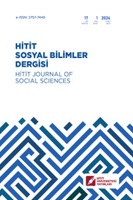Borsa İstanbul’da Yatırımcı İlgisi: Google Trendleri ve Youtube İzlenmelerinin İlk Halka Arz Performanslarına Etkisinin Rassal Orman Yöntemi ile Analizi
Investor Attention in Borsa Istanbul: Analysis of the Effect of Google Trends and Youtube Views on Initial Public Offering Performances by Random Forest Method
Author(s): Yunus Emre AkdoganSubject(s): Media studies, ICT Information and Communications Technologies, Socio-Economic Research
Published by: Hitit Üniversitesi
Keywords: Initial Public Offering; Investor Attention; Random Forest; Google Trends; Youtube;
Summary/Abstract: The "efficient markets hypothesis", which is one of the asset pricing models of traditional finance theory, is based on the assumption that publicly available information is reflected in prices by rational investors with perfect information, and therefore it is not possible to obtain abnormal returns. On the other hand, models based on the assumption of bounded rationality argue that investors have cognitive constraints and one of these constraints is investor attention. Investor attention is a cognitive constraint that leads investors to focus only on a set of information, thus limiting their access to information. This constraint is used as a signal for stock price movements because it leads investors to buy only those stocks about which they have information. However, there are different views on how to measure investor attention. Approaches that measure investor attention indirectly use indirect proxies such as price, liquidity, return, and advertising expenditures, while approaches that measure investor attention directly either ask investors directly or monitor their behavior. Especially with the advancements in information and communication technologies, the widespread use of social media by investors to access investment ideas offers new tools to directly measure investor attention. Among these tools based on investors' information-seeking behaviors are Google and Baidu search volumes, Wikipedia page views, and tweets. Another financial dynamic influenced by investor attention is initial public offerings (IPOs). An IPO refers to the process of offering a firm's shares to the public in the primary market. Therefore, in an IPO, firms raise capital by offering their shares through the primary market. Predicting the performance of a stock in an IPO is crucial for both firms and investors. In this study, we use Google search volumes of firm names and symbols prior to the IPO as proxies of investor attention and the number of views of YouTube content that provides brief information about the IPO company and examine their impact on the performance of initial public offerings in Borsa Istanbul. The study also investigates which firm-specific characteristics are related to investor attention. In other words, it is also investigated which variables such as IPO size, number of shares, IPO price, reason for IPO, sector of the firm, and financial ratios attract more investor attention. As a result of the research, it was found that YouTube view counts are a better proxy for investor attention than Google search volumes. Within the scope of this study, both instruments used as proxies of investor attention are consistent with the assumption of bounded rationality, where perfect information is not available and cognitive abilities are limited. Additionally, the findings also suggest that investors value a firm's fundamental value and internal growth potential. Another aim of this study is to develop narrow artificial intelligence capable of making decisions regarding IPOs or supporting investor decisions within the scope of algorithmic financial transactions. Artificial intelligence is defined as the ability of a computer to perform various activities similar to intelligent beings. Super artificial intelligence refers to those with superhuman abilities; general artificial intelligence is designed to perform any task a human can perform; narrow artificial intelligence refers to artificial intelligence designed to perform a specific task. Therefore, each model developed within the scope of narrow artificial intelligence actually adds a new skill to general artificial intelligence. In this context, the findings obtained from this study provide a significant contribution to the development of financial artificial intelligence applications, especially in training bots engaged in algorithmic financial transactions related to IPOs. In other words, in practice, this study presents a narrow financial artificial intelligence product whose framework is limited to IPO performances, while in theory it reveals the determinants of investor attention.
Journal: Hitit Sosyal Bilimler Dergisi
- Issue Year: 17/2024
- Issue No: 1
- Page Range: 70-90
- Page Count: 21
- Language: Turkish

